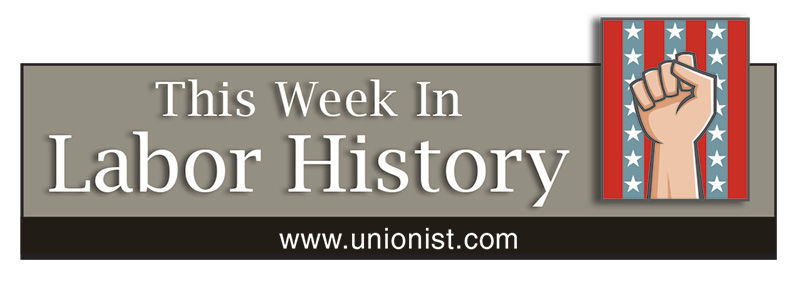
AUGUST 24
1970 – United Farm Workers Union begins lettuce strike.
AUGUST 25
1925 – Brotherhood of Sleeping Car Porters founded at a meeting in New York City. A. Philip Randolph became the union’s first organizer.
AUGUST 26
1919 – Fannie Sellins and Joseph Starzeleski are murdered by coal company guards on a picket line in Brackenridge, Pa. Sellins was a United Mine Workers of America organizer and Starzeleski was a miner.
1920 – After three-quarters of the states had ratified the 19th Amendment to the Constitution, women win their long struggle for the vote.
1970 – The Women’s Strike for Equality is staged in cities across the U.S., marking the 50th anniversary of the passage of the 19th amendment, under which women won the right to vote. A key focus of the strike — in fact, more accurately a series of marches and demonstrations — was equality in the workplace. An estimated 20,000 women participated, some carrying signs with the iconic slogan, “Don’t Iron While the Strike is Hot.” Another sign: “Hardhats for Soft Broads.”
2003 – More than 1,300 bus drivers on Oahu, Hawaii, begin what is to become a five-week strike.
AUGUST 27
1934 – Some 14,000 Chicago teachers who have gone without pay for several months finally collect about $1,400 each.
1950 – President Truman orders the U.S. Army to seize all the nation’s railroads to prevent a general strike. The railroads were not returned to their owners until two years later.
AUGUST 28
1963 – The March on Washington for Jobs and Freedom — the Martin Luther King Jr. “I Have A Dream” speech march — is held in Washington, D.C., with 250,000 participating. The AFL-CIO did not endorse the march, but several affiliated unions did.
2017 – Effective on this day, the hourly minimum wage in St. Louis MO was reduced from $10 to $7.70 due to action by the Republican-controlled MO state legislature, prohibiting cities from setting a minimum wage rate higher than the state rate.
AUGUST 29
1889 – Sixty letter carriers from 18 states meet in a room above Schaefer’s Saloon on Plankinton Avenue in Milwaukee. They unanimously adopt a resolution to form a National Association of Letter Carriers.
1907 – Seventy-five workers die when the lower St. Lawrence River’s Quebec Bridge collapses while under construction. A flawed design was found to be the cause. Thirteen more workers were killed nine years later when the reconstructed bridge’s central span was being raised and fell into the river because of a problem with hoisting devices.
1996 – Dancers at San Francisco’s Lusty Lady Club vote 57-15 to be represented by SEIU Local 790. Their first union contract, ratified eight months later, guaranteed work shifts, protection against arbitrary discipline and termination, automatic hourly wage increases, sick days, a grievance procedure, and removal of one-way mirrors from peep show booths.
1998 – Northwest Airlines pilots, after years of concessions to help the airline, begin what is to become a two-week strike for higher pay.
2000 – Delegates to the Minnesota AFL-CIO convention approve the launching of workdayminnesota.org. It was the first web-based daily Labor news service by a state Labor federation.
AUGUST 30
1834 – Delegates from several East Coast cities meet in convention to form the National Trades’ Union, uniting craft unions to oppose “the most unequal and unjustifiable distribution of the wealth of society in the hands of a few individuals.” The union faded after a few years.
1935 – President Franklin Roosevelt’s Wealth Tax Act increases taxes on rich citizens and big business, lowers taxes for small businesses.
1996 – OSHA publishes scaffold safety standard, designed to protect 2.3 million construction workers and prevent 50 deaths and 4,500 injuries annually.
(Compiled by David Prosten, founder Union Communication Services)

